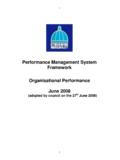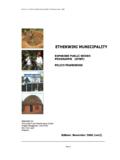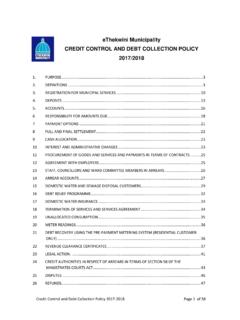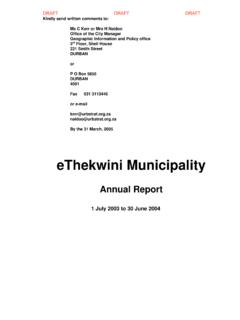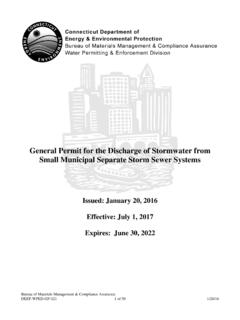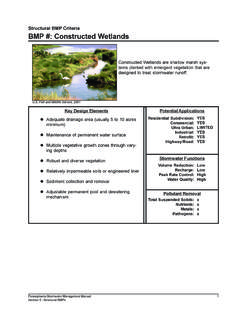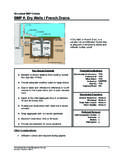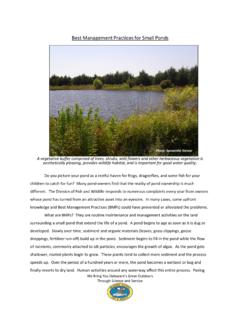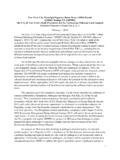Transcription of ETHEKWINI DESIGN MANUAL - Durban
1 ENGINEERING UNITCOASTAL stormwater & CATCHMENT management DEPARTMENTDESIGN MANUAL : GUIDELINES AND POLICY FOR THE DESIGN OF STORMWATERDRAINAGE AND stormwater management SYSTEMS(Vade Mecum)Issued by :R. KASSERCHUN HEAD : CSCMMUNICIPAL CENTRE 166 OLD FORT ROADDURBAN4001 Revision Date: May 20081 ETHEKWINI MUNICIPALITYDESIGN MANUAL : GUIDELINES AND POLICY FOR THE DESIGN OFSTORMWATER DRAINAGE AND stormwater MANAGEMENTSYSTEMSINTRODUCTIONT hese guidelines and policies are applicable to the DESIGN of minor stormwater reticulationand collection systems and for the management and control of stormwater runoff from sitesby means of soakpits and attenuation tanks and runoff discharge controls. These guidelines include recommendations for the sizing and DESIGN of stormwater soakpits,attenuation structures/ponds, outlet discharge controls/overflows, kerb inlets, manholes, roadedge channels, watercourses, underground pipelines and small channels.
2 These must bedesigned to effectively collect, control and convey run-off from storms to larger or majordrainage DESIGN of all major stormwater systems (whether culverts, pipes, canals, including roadcrossings, bridges etc.), for catchments greater than 1 km where hydraulic analysis of thewaterway is necessary, should be carried out by checking by a registered professionalengineer proficient in this field for approval by Coastal, stormwater & CatchmentManagement Unit. Limited information related to the drainage and storage facilities to be used in a majordrainage system for the control of floods has been included in these guidelines. These guidelines should be read in conjunction with the stormwater management section ofthe Guidelines for the provision of Engineering Services and Amenities in ResidentialTownship Development (the Red book) issued by the National Housing and highway crossings and jacked pipes normally require special measures and shouldbe referred to the Deputy Head: Coastal stormwater and Catchment Date.
3 May 20082 CONTENTS1 stormwater management POLICY page of of attenuation and other storage outline of minimum information required in a stormwater management plan2 THE RATIONAL METHOD page on of catchment 'A' of concentration 'Tc' coefficient 'C' intensity 'I'3 DESIGN OF A MINOR SYSTEM page intensity at critical velocity and of stormwater sewers in of stormwater sewers in road in levels at OF CLASS OF PIPE page 205 PARTIAL FLOW IN PIPES page 206 SUBSOIL DRAINS page 207 STORAGE PONDS page 208 DESIGN OF SHORT LENGTH CULVERTS UNDER EMBANKMENTS page 219 CALCULATING TIME OF CONCENTRATION page 2110 EXAMPLES OF CALCULATING THE RUNOFF COEFFICIENT Cpage 2211 METHOD OF stormwater RETICULATION DESIGN page 2412 GENERAL METHODOLOGY page 2413 WORKED EXAMPLE page 27 Revision Date: May 2008314 DESIGN OF stormwater KERB INLETS page 3315 CALCULATIONS OF INVERT LEVELS AT MANHOLES page 34 LIST OF APPENDICES page 35 PART R stormwater Disposal SABS 0400 - 1990page 36 Hydraulic elements of circular sectionspage 38 Bend lossespage 39 Details of anchor blockspage 40 Discharge through box culverts : inlet control page 41 Discharge through pipe culverts : inlet control page 42 Kerb Inlet chart 1: cross fall 2%page 43 Kerb Inlet chart 2: cross fall 2,5%page 44 Kerb Inlet chart 3 & 4.
4 Cross fall 4% and 6%page 45 Pipe bedding detailspage 46 Protection of pipes at reduced depths of coverpage 47 Recommended layout of services - metre reserve page48 Recommended layout of services - 12 metre reservepage 49 Recommended layout of services - 16 metre reserve page 50 Recommended layout of services - 19 metre reservepage 51 Revision Date: May 200841 stormwater management POLICYM unicipal stormwater availabilityIn many instances erven do not have access or connections to municipal stormwater . Insuch cases the onus is placed on the developer to manage the excess stormwater resultingfrom any hardening of the site area. This management can take the form of soakpits if thesoil and geological profiles allow or attenuation facilities such as tanks, ponds or areasdesigned to retain water.
5 Where possible the emphasis should be placed on improving thepotential for groundwater infiltration. Municipal infrastructure generally provided stormwater systems designed on the basis thatnot more than 40% of the area of residential properties would be hardened. As such, anydevelopment in such areas in excess of a 40% limitation naturally implies that the developermust be held responsible to manage the excess runoff from such a site for the proportion ofhardening in excess of 40%.Where sites have historically disposed of stormwater into soakpits on site, this method ofdisposal must be maintained. Notwithstanding, soakpits cannot function effectively forever(life spans are limited to 5 to 15 years depending on the DESIGN and maintenance). Theobligation is thus placed on the owner to maintain and upgrade the existing soakpit capacitywhere any further development or hardening of the site occurs.
6 These responsibilities are necessary and due. Changing conditions and trends have lead toincreased development densification. Increasingly, paving is replacing higher maintenancelawns and garden areas and a process of maximizing land usage to supplement changing trends in residential and semi-urban areas have seen rezoning and newsectional type developments resulting in higher rates and volumes of runoff. Therefore, In accordance with the National Building Regulations PART R StormwaterDisposal SABS 0400 1990 (See Appendix), the ETHEKWINI Municipal policy requires thatprivately owned sites may be required to manage and make provision for their ownstormwater runoff. The general level of management required is that of controlling all runoff emanating fromsuch a site in excess of that which would have occurred if the site was in its natural ororiginal virgin state.
7 Such stormwater management may well be the provision of soak pits,structures such as attenuation ponds or tanks (with controlled outlets where necessary, all toensure that the rate of runoff is reduced to predevelopment states and that runoff is notconcentrated onto adjacent neighbouring sites or other infrastructure, be it road drainage orvalley lines, streams of soakpits In general, where a site was originally developed with attenuation structures/ponds orsoakpits controlling runoff, these systems should remain. These sites are alsorequired to maintain and upgrade their systems to accommodate both existing andany new additional hardening on the application for approval of development on any open site without access tomunicipal stormwater will be required to provide a stormwater management planbased on a rational DESIGN method demonstrating that the soakpit/attenuation andother proposed controls controlling the additional stormwater runoff generated due toall the development of the site will not adversely affect downstream and neighbouringareas.)
8 All designs are subject to the approval of the Coastal, stormwater &Catchment management Department of the ETHEKWINI Engineering Date: May 20085 Additionally, existing single erven or properties that have a municipal stormwaterconnection, but where the site has been developed to the point where more than 40%of the site area has been hardened may be required to manage the excess runoffgenerated on the site/erf of the site may be by either roofed areas or by otherwise generating morestormwater runoff by providing paved driveways or other semi or impermeablestructures cumulatively covering in excess of 40 % of the area of the site or erf. If thegeological and stability profile of the site is suitable soakpits sized on the basis of theexcess hardened coverage of 40 % are to be provided or other engineeredattenuation measures based on an engineers DESIGN and the Rational method ofdetermining pre to post development existing/old soakpits are very rudimentary sheet iron covered rubble filledholes.
9 These older soakpits had a effective lifespan rarely in excess of 10 cannot be cleaned or maintained and the initial storage volume provided wasgenerally minimal. Properly designed structures provide access to allow for essentialperiodic removal of accumulated silt, organic material and other windblown materialsfrom the soakpit to allow it to continue to function effectively. Regular maintenanceextends the soakpits life span and maintains storage volume. When drawings are submitted for approval of building additions and alterations andthe property had existing soakpits, then the developer must be able to demonstratethat the existing soakpits are functioning. These existing soakpits will have over timebeen filled with detritus and in many cases have been displaced by excavations forpools or other structures etc.
10 The original soakpits cannot be accepted unless theywere constructed properly and can be accessed for cleaning or inspection. Currentpolicy dictates that approval for any new addition on sites with soakpits must makeprovision for installing new soakpits unless a professional engineer is able to inspectthe old/existing soakpits and certify the capacity and condition. As such, new properly designed soakpits for stormwater shall be built, sized on thebasis of 1 (one) cubic metre of clear volume to drain each and every 40 squaremetres of all roofed, paved or otherwise hardened areas on that are some alternatives to using soakpits and these include the provision ofrainwater tanks which can be used for watering gardens and/or engineered may be an attractive alternative to soakpits providing a stored source ofirrigation water.
